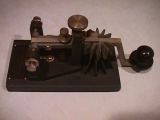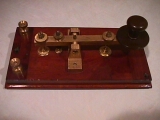THE BRAVO YANKEE DX RADIO ASSOCIATION
27.900.70 - 27.999.00 CW


CW frequency segment
MEMBERS THE LIKE WORK CW ARAUND THE WORLD IN BRAVO YANKEE TEAM TOBE IN THE CONTAC FRECUENCY DESIGNED FOR DX ARRUND THE WORLD 27.900.70 27.999.0 CW every people and MEMBERS PERTAINING OF BRAVO YANKEE TEAM. EVERYBODY RADIO OPERATOR A LIKE AND ENJOY THE GOOD"S CONTAC IN CW IN THE SEGMENT OF THE FREE BAN ( 11 METER BAN ) . I HAVE ONE FRECUENCY CONTAC IN CW MODALITY IT IS 27.900.70 CW WELCOME EVERY BODY RADIO OPERATOR IN THE WORLD I LIKE PROFECIONAL WORK OF THE CW MODALITY .
EVERY BODY PEOPLE ENJOY OF THE TELEGRAPHI CONTAC TO SEE WELCOME AND THANKS FOR YOURS VISIT"S .
![]()
|
|||||||||||||||||||||||||||||||||||||||||||||||||||||||||||||||||||||||||||||||||||||||||||||||||||||||||||||||||||||
33 fondest regards
55 best succes
73 best regards
88 love and kisses
abt about
ads adress
agn again
ani any
ans answer
ant antenna
awdh auf wiederhoeren
b4 before
bcnu be seeing you
bcp beaucoup (french)
bd bad
bjr bonjour (french)
bk break
bth both
buro bureau
c yes
cb (1) callbook
cb (2) citizensband
cba callbook address
cfm confirm
cl closing
clg calling
clix key-clicks
cmg coming
condx conditions
congrats congratulations
cpi copy
cq general call
crd card
cs callsign
cuagn call you again
cud could
cul call you later
cuz because
cw continuous wave
de from
dr dear
dsw see you again (russian)
dwn down
dx long distance
el element
enuf enough
es and
eu europe
eve evening
fb fine business
fd fieldday
fer for
fm from
fone telephony
fq frequency
freq frequency
fwd forward
ga go ahead
ga good afternoon
gb goodbye
gd good day
ge good evening
gg going
gld glad
gm good morning
gn good night
gnd ground
gp ground plane
gs green stamp
gud good
ham radio amateur
hi high
hi laughter
hpe hope
hq headquarters
hr here
hr hour
hrd heard
hrs hours
hv have
hvg having
hvy heavy
hw how
hw? how did you copy?
ii I repeat
info information
inpt input
ja japan
k invitation to transmit
klix keyclicks
lid poor operator
lis liscensed
lp long path
lsn listen
lw long wire
mci merci (french)
mgr manager
mi my
mni many
mom moment
msg message
mult multiplier
n no
n 9 (as in RST-report)
nfd national fieldday
nil nothing
nr number
nr near
nw now
ob old boy
oc old chap
ok correct
om old man
onli only
op operator
opr operator
ot old timer
ow old woman
pse please
pwr power
px prefix
px press
You will find the Q-code list here
r received OK
rcvd received
rcvr receiver
rig radio equipment
rprt report
rpt repeat
rx receiver
sa say
sed said
shud should
sig signature
sigs signals
sk silent key
sked schedule
sn soon
sp short path
sri sorry
stn station
sum some
swl short wave listener
temp temperature
test test
test contest
tfc traffic
thru through
til until
tks thanks
trbl trouble
trx transceiver
tt that
tu thank you
tx transmitter
txt text
u you
ufb ultra fine business
unlis unlicensed
up upward
ur your
urs yours
vert vertical
vx vieux (french)
vy very
watsa what do you say
wid with
wkd worked
wkg working
wl will
wpm words per minute
wrk work
wud would
ww would
wx weather
xcvr transceiver
xmas christmas
xmtr transmitter
xtal crystal
xyl wife
yf wife
yl young lady
yr year
z zulu-time (=UTC)
Morse Code (-- --- •-• ••• • -•-• --- -•• •)
Origin
Morse Code was invented by Samuel F. B. Morse (1791-1872), a painter and founder of the National Academy of Design. He conceived the basic idea of an electromagnetic telegraph in 1832, and produced the first working telegraph set in 1836. This made transmission possible over any distance. The first Morse Code message, "What hath God wrought?", was sent from Washington to Baltimore.
Today experienced operators copy received text without the need to write as they receive, and when transmitting, can easily converse at 20 to 30 words per minute. Morse Code will always remain a viable means of providing highly reliable communications during difficult communications conditions.
Morse Code can be transmitted using sound or light, as sometimes happens between ships at sea. It is used in emergencies to transmit distress signals when no other form of communication is available. The standard international distress signal is •••---••• (SOS)
Since December 2003, Morse Code has included the @ symbol: it is a combination of a and c: •--•-• and is the first change to the system since before World War II.
Letters
| •- | -••• | -•-• | -•• | • | ••-• | --• | •••• | •• | •--- | -•- |
| a | b | c | d | e | f | g | h | i | j | k |
| •-•• | -- | -• | --- | •--• | --•- | •-• | ••• | - | ••- | •••- |
| l | m | n | o | p | q | r | s | t | u | v |
| •-- | -••- | -•-- | --•• | •-•- | •--•- | ---- | ••-•• | --•-- | ---• | ••-- |
| w | x | y | z | ä | á | ch | é | ñ | ö | ü |
Punctuation
| •-•-•- | --••-- | ••--•• | •----• | -•-•-- | -••-• |
| fullstop/ period |
comma | question mark |
apostrophe | exclamation mark |
slash |
| -••••- | -••-• | -•--•- | •-••-• | ||
| hyphen | fraction bar |
parentheses | quotation marks |
Numbers
| •---- | ••--- | •••-- | ••••- | ••••• | -•••• | --••• | ---•• | ----• | ----- |
| 1 | 2 | 3 | 4 | 5 | 6 | 7 | 8 | 9 | 0 |
|
American |
International |
| A . _ | . _ |
| B _ . . . | _ . . . |
| C . . . | _ . _ . |
| D _ . . | _ . . |
| E . | . |
| F . _ . | . . _ . |
| G _ _ . | _ _ . |
| H . . . . | . . . . |
| I . . | . . |
| J _ . _ . | . _ _ _ |
| K _ . _ | _ . _ |
| L _____ | . _ . . |
| M _ _ | _ _ |
| N _ . | _ . |
| O . . | _ _ _ |
| P . . . . . | . _ _ . |
| Q . . _ . | _ _ . _ |
| R . . . | . _ . |
| S . . . | . . . |
| T _ | _ |
| U . . _ | . . _ |
| V . . . _ | . . . _ |
| W . _ _ | . _ _ |
| X . _ . . | _ . . _ |
| Y . . . . | _ . _ _ |
| Z . . . . | _ _ . . |
| 1 . _ _ . | . _ _ _ _ |
| 2 . . _ . . | . . _ _ _ |
| 3 . . . _ . | . . . _ _ |
| 4 . . . . _ | . . . . _ |
| 5 _ _ _ | . . . . . |
| 6 . . . . . . | _ . . . . |
| 7 _ _ . . | _ _ . . . |
| 8 _ . . . . | _ _ _ . . |
| 9 _ . . _ | _ _ _ _ . |
| 0 ______ | _ _ _ _ _ |
|
|
||||||||||||||||||||||||||||||||||||||||||||||||||||||||||||||||||||||||||||||||||||||||||||||||||||||||||||||||||||||||||||








